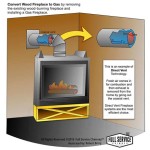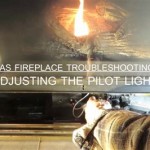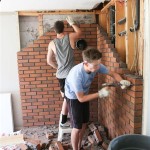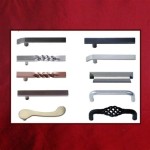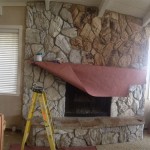Drafty Gas Fireplace: Causes, Consequences, and Solutions
A drafty gas fireplace can be a significant source of discomfort and increased energy bills within a home. While designed to provide supplemental heat and ambiance, a poorly sealed or improperly functioning gas fireplace can become a conduit for cold air infiltration from the outside, effectively negating its intended purpose. Understanding the causes of these drafts is crucial for implementing effective solutions and restoring the fireplace's efficiency.
This article will explore the common reasons behind a drafty gas fireplace, the potential problems these drafts can cause, and provide actionable strategies for identifying and resolving the issue. Addressing a drafty gas fireplace not only enhances comfort but also contributes to energy savings and improved indoor air quality.
Identifying the Source of the Draft
Pinpointing the exact location of the draft is the first step towards resolving the problem. Several areas of the fireplace system are potential sources of cold air infiltration. The following methods can aid in identifying these areas:
The Hand Test: This simple method involves moving a hand slowly around the fireplace opening, the glass door (if present), and the surrounding area of the fireplace enclosure. A noticeable drop in temperature or a sensation of moving air can indicate the presence of a draft.
The Candle Test: A lit candle or incense stick can be used to visually identify airflow. By holding the candle near potential draft sources, observing the flame's flicker or the direction of the smoke can reveal the presence and direction of air movement. Extreme caution should be exercised when using open flames near flammable materials.
The Smoke Test: A smoke pencil or similar device, which emits a small, controlled stream of smoke, can be used to pinpoint even subtle drafts. The smoke will visually demonstrate the direction of airflow, allowing for precise identification of leaks.
Once the general area of the draft is identified, closer inspection is necessary to determine the specific cause. Common culprits include gaps around the fireplace surround, cracks in the mortar, and issues with the chimney damper or vent system.
Common Causes of Drafty Gas Fireplaces
Several factors can contribute to a drafty gas fireplace. Understanding these common causes allows for targeted troubleshooting and effective repairs. It's important to remember that working on gas appliances can be dangerous, and consulting a qualified professional is recommended for any repairs involving gas lines or venting systems.
Damper Issues: In fireplaces originally designed for wood burning but converted to gas, the damper may not be properly sealed. Even when closed, a warped or damaged damper can allow significant airflow. Furthermore, some gas fireplaces lack a dedicated damper, relying instead on a vent system designed for continuous airflow. In these cases, a sealing device, such as a chimney balloon, may be necessary to prevent drafts when the fireplace is not in use.
Air Leaks Around the Fireplace Surround: Gaps between the fireplace surround and the surrounding wall or floor are a common source of drafts. These gaps can be caused by settling of the house, poor initial installation, or damage to the surrounding materials. Inspecting the perimeter of the fireplace, both inside and outside the home, is essential for identifying potential leak points.
Chimney Design and Stack Effect: The chimney itself can contribute to drafts due to a phenomenon called the stack effect. Warm air naturally rises, creating a pressure difference between the inside and outside of the house. This pressure difference can draw cold air down the chimney and into the fireplace, especially on windy days. Tall chimneys and poorly insulated flues exacerbate this effect.
Cracks and Mortar Deterioration: Over time, the mortar joints between bricks or stones in the chimney and fireplace can deteriorate, creating cracks that allow air infiltration. Regular inspection of the chimney and fireplace structure is necessary to identify and repair any damaged mortar. This is especially important in older homes.
Improper Venting: Gas fireplaces require proper venting to safely exhaust combustion gases. If the venting system is improperly sized, blocked, or damaged, it can not only create a safety hazard but also contribute to drafts. A professional inspection is crucial to ensure the venting system meets safety standards and functions correctly.
Solutions for a Drafty Gas Fireplace
Once the source and cause of the drafts have been identified, appropriate solutions can be implemented. The specific remedy will depend on the nature and severity of the problem. In many cases, a combination of approaches may be necessary.
Sealing Air Leaks: Caulking or weather stripping can be used to seal gaps around the fireplace surround. Applying caulk to the exterior and interior joints where the fireplace meets the wall or floor can effectively block air infiltration. Weather stripping can be used to seal gaps around the fireplace door, if one is present.
Damper Repair or Replacement: If the damper is damaged or warped, it may need to be repaired or replaced. In cases where the fireplace lacks a damper entirely, installing a chimney balloon or other sealing device can effectively block airflow when the fireplace is not in use. Ensure that any sealing device is removed before operating the fireplace.
Chimney Insulation: Insulating the chimney flue can help reduce the stack effect and minimize drafts. This can be achieved by installing a chimney liner with insulation or by wrapping the exterior of the chimney with insulating materials. Consult with a qualified professional to determine the best insulation method for the specific chimney type and construction.
Mortar Repair (Repointing): Deteriorated mortar joints should be repaired through a process called repointing. This involves removing the old, crumbling mortar and replacing it with new mortar. Repointing not only prevents drafts but also helps to preserve the structural integrity of the chimney and fireplace.
Professional Venting Inspection and Repair: Any issues with the venting system should be addressed by a qualified HVAC technician or fireplace specialist. A professional can inspect the venting system for blockages, damage, or improper sizing and recommend the appropriate repairs or modifications. This is crucial for ensuring the safe and efficient operation of the gas fireplace.
By carefully identifying the source of the draft and implementing the appropriate solutions, homeowners can effectively eliminate drafts from their gas fireplaces, improving comfort, reducing energy consumption, and enhancing the overall efficiency of their heating systems. Remember that safety should always be the top priority when working with gas appliances, and consulting with qualified professionals is highly recommended for any repairs involving gas lines or venting systems.

Fireplace Cover To Keep Cold Air Out

Our Gas Fireplace Is So Drafty It S Like An Open Window Floor Roof House Remodeling Decorating Construction Energy Use Kitchen Bathroom Bedroom Building Rooms City Data Forum

Stop Cold Air From Wood Or Gas Fireplace

How To Stop Fireplace Drafts Seal A Opening Cold Air Coming From

How To Stop Fireplace Drafts Seal A Opening Cold Air Coming From

How Can I Stop The Cold Air Draft Coming From My Masonry Fireplace

Gas Fireplace Draft

How To Fix A Drafty Fireplace Chimney Sweeps Repairs And Installations

Natural Draft Direct Vent Lopi Fireplaces

How To Stop Fireplace Drafts Full Service Chimney

